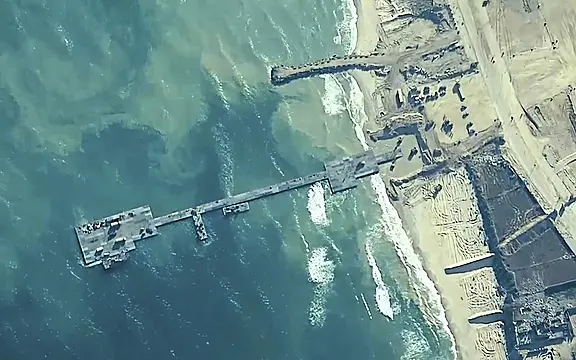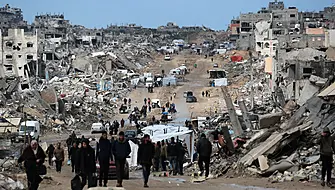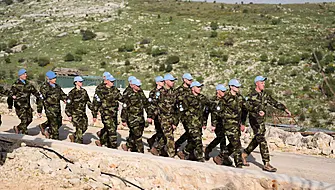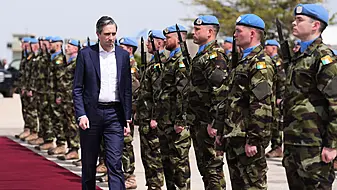Trucks carrying badly-needed aid for the Gaza Strip have rolled across a newly built US floating pier into the besieged enclave for the first time.
It came as Israeli restrictions on border crossings and heavy fighting hindered the delivery of food and other supplies.
The Friday shipment is the first in an operation that American military officials anticipate could scale up to 150 truckloads a day entering the Gaza Strip as Israel presses in on the southern city of Rafah as its seven-month offensive against Hamas rages on.
US officials and aid groups warned the pier project is not considered a substitute for land deliveries that could bring in all the food, water and fuel needed in Gaza.
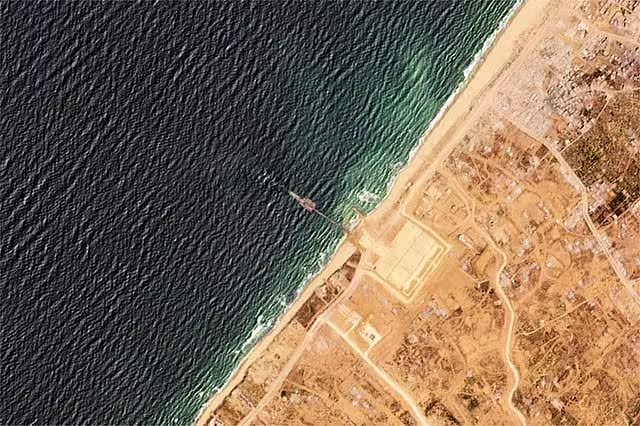
Before the war, more than 500 truckloads entered Gaza on an average day.
The operation’s success also remains tenuous due to the risk of militant attack, logistical hurdles and a growing shortage of fuel for the trucks to run due to the Israeli blockade of the Gaza Strip since Hamas’s October 7th attack on Israel that killed 1,200 people and took 250 others hostage.
Israel’s offensive since then has killed more than 35,000 Palestinians in the Gaza Strip, local health officials say, while hundreds more have been killed in the West Bank.
Aid agencies say they are running out of food in southern Gaza and fuel is dwindling, while the US Agency for International Development and the UN World Food Programme say famine has already taken hold in Gaza’s north.
The first shipment of UK aid has successfully been delivered across the temporary pier off Gaza.
Our Armed Forces alongside our partners have played a central role in delivering this support.
More land routes must open so much more aid gets to where it's needed most. pic.twitter.com/7t2P1BQQh5— Rishi Sunak (@RishiSunak) May 17, 2024
Troops finished installing the floating pier on Thursday and the US military’s Central Command said the first aid crossed into Gaza at 9am on Friday. It said no American troops went ashore in the operation.
The Pentagon said no delays were expected in the distribution process. The US plan is for the UN to take charge of the aid once it leaves the pier. The world body’s World Food Programme will then turn it over to aid groups for delivery.
The UK said some of its aid for Gaza was in the first shipment that went ashore, including the first of 8,400 kits to provide temporary shelter made of plastic sheeting. And it said more aid, including 2,000 additional shelter kits, 900 tents, five forklift trucks and 9,200 hygiene kits, will follow in the coming weeks.
“This is the culmination of a herculean joint international effort,” UK prime minister Rishi Sunak said.
“We know the maritime route is not the only answer. We need to see more land routes open, including via the Rafah crossing, to ensure much more aid gets safely to civilians in desperate need of help.”
Aid distribution had not yet begun as of Friday afternoon, said a UN official. The official said the process of unloading and reloading cargo was still ongoing.
The UN humanitarian aid co-ordinating agency said the start of the operation was welcome but not a replacement for deliveries by land.
“I think everyone in the operation has said it: Any and all aid into Gaza is welcome by any route,” spokesperson Jens Laerke, of the Office for the Co-ordination of Humanitarian Affairs, told journalists in Geneva on Friday. Getting aid to people in Gaza “cannot and should not depend on a floating dock far from where needs are most acute”, he added.
The UN earlier said fuel deliveries brought through land routes have all but stopped and that would make it extremely difficult to bring the aid to Gaza’s people.
“It doesn’t matter how the aid comes, whether it’s by sea or whether by land, without fuel, aid won’t get to the people,” said UN deputy spokesperson Farhan Haq.

Pentagon spokeswoman Sabrina Singh said the issue of fuel deliveries comes up in all US conversations with the Israelis.
She also said the plan is to begin slowly with the sea route and ramp up the truck deliveries over time as they work the kinks out of the system.
Israel fears Hamas will use fuel in the war, but it asserts it places no limits on the entry of humanitarian aid and blames the UN for delays in distributing goods entering Gaza. Under pressure from the US, Israel has opened a pair of crossings to deliver aid into the territory’s hard-hit north in recent weeks.
It has said that a series of Hamas attacks on the main crossing, Kerem Shalom, have disrupted the flow of goods. The UN says fighting, Israeli fire and chaotic security conditions have hindered delivery. There have also been violent protests by Israelis that disrupted aid shipments.
Israel recently seized the key Rafah border crossing in its push against Hamas around that city on the Egyptian border, raising fears about civilians’ safety while also cutting off the main entry for aid into the Gaza Strip.
US President Joe Biden ordered the pier project, expected to cost $320 million.
The boatloads of aid will be deposited at a port facility built by the Israelis just south-west of Gaza City and then distributed by aid groups.
US officials said the initial shipment totalled as much as 500 tons of aid. The US has closely co-ordinated with Israel on how to protect the ships and personnel working on the beach.

But there are still questions about the safety of aid workers who distribute the food, said Sonali Korde, assistant to the administrator of USAID’s Bureau for Humanitarian Assistance, which is helping with logistics.
“There is a very insecure operating environment,” and aid groups are still struggling to get clearance for their planned movements in Gaza, Ms Korde said.
That concern was highlighted last month when an Israeli strike killed seven relief workers from World Central Kitchen whose trip had been co-ordinated with Israeli officials. The group had also brought aid in by sea.
Pentagon officials have made it clear that security conditions will be monitored closely and could prompt a shutdown of the maritime route, even if just temporarily. Navy Vice Admiral Brad Cooper, a deputy commander at the US military’s Central Command, told reporters on Thursday that “we are confident in the ability of this security arrangement to protect those involved”.
Already, the site has been targeted by mortar fire during its construction, and Hamas has threatened to target any foreign forces who “occupy” the Gaza Strip.
Mr Biden has made it clear that there will be no US forces on the ground in Gaza, so third-country contractors will drive the trucks onto the shore.
Israeli forces are in charge of security on shore, but there are also two US navy warships nearby that can protect US troops and others.
The aid for the sea route is collected and inspected in Cyprus, then loaded onto ships and taken about 200 miles to the large floating pier off the Gaza coast.
